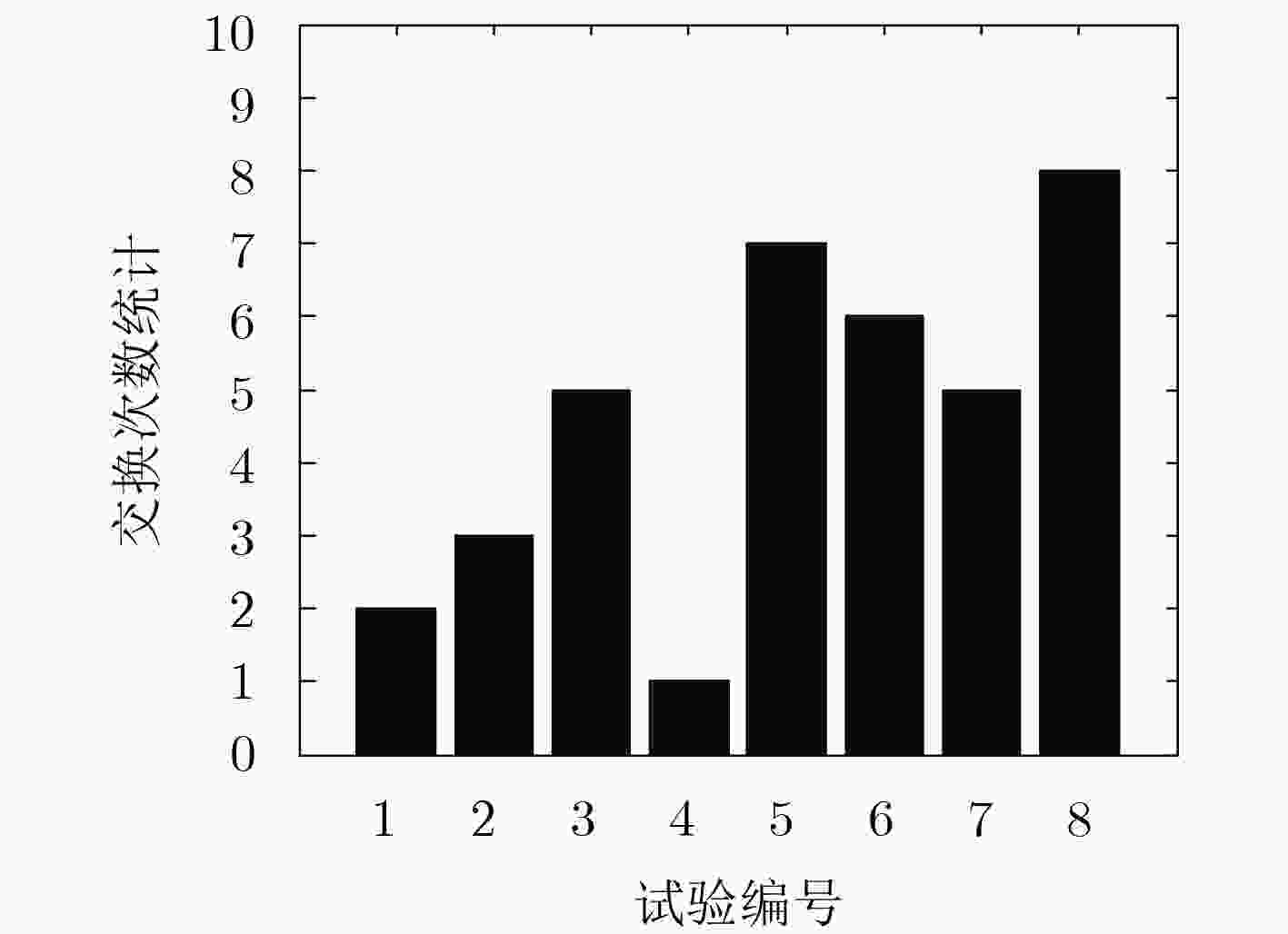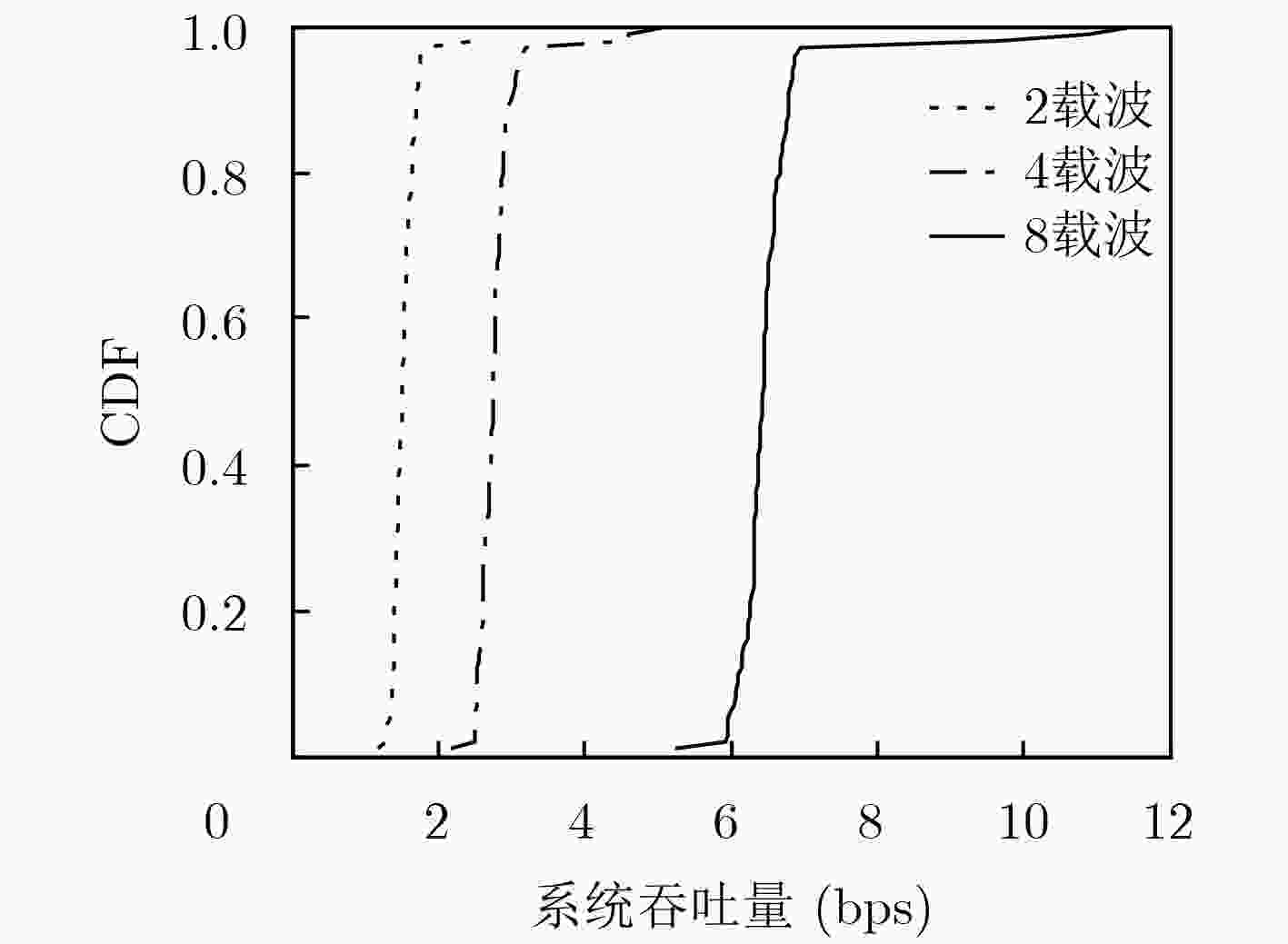A Cluster Algorithm Based on Interference Increment Reduction in Ultra-Dense Network
-
摘要:
超密集网络(UDNs)拉近了终端与节点间的距离,使得网络频谱效率大幅度提高,扩展了系统容量,但是小区边缘用户的性能严重下降。合理规划的虚拟小区(VC)只能降低中等规模UDNs的干扰,而重叠基站下的用户的干扰需要协作用户簇的方法来解决。该文提出了一种干扰增量降低(IIR)的用户分簇算法,通过在簇间不断交换带来最大干扰的用户,最小化簇内的干扰和,最终最大化系统和速率。该算法在不提高K均值算法的复杂度的同时,不需要指定簇首,避免陷入局部最优。仿真结果表明,网络密集部署时,有效提高系统和速率,尤其是边缘用户的吞吐量。
Abstract:Ultra-Dense Networks (UDNs) shorten the distance between terminals and nodes, which improve greatly the spectral efficiency and expand the system capacity. But the performance of cell edge users is seriously degraded. Reasonable planning of Virtual Cell (VC) can only reduce the interference of moderate scale UDNs, while the interference of users under overlapped base stations in a virtual cell needs to be solved by cooperative user clusters. A user clustering algorithm with Interference Increment Reduction (IIR) is proposed, which minimizes the sum of intra-cluster interference and ultimately maximizes system sum rate by continuously switching users with maximum interference between clusters. Compared with K-means algorithm, this algorithm, no need of specifying cluster heads, avoids local optimum without increasement of the computation complexity. The simulation results show that the system sum rate, especially the throughput of edge users, can be effectively improved when the network is densely deployed.
-
Key words:
- Ultra-Dense Network (UDN) /
- Virtual Cell (VC) /
- Cluster /
- Sum rate /
- Cell-edge users
-
表 1 参数含意对照表
参数 意义 参数 意义 $C$ 全部虚拟小区的集合 ${{\text{W}}_i}$ ${U_i}$中用户的预编码矩阵 ${C_i}$ 为用户i服务的虚拟小区 ${c_i}$ 预编码矩阵的功率约束条件 $U$ 全部用户的集合 $V\;$ 用户分簇集合 ${U_j}$ 第j个虚拟小区所服务的所有用户的集合 ${V_g}$ 第g个簇中的用户集合 ${{\text{H}}_{i,{C_i}}}$ 用户i在虚拟小区${C_i}$服务下的信道矢量 $R_e^{[g]}$ 第g个簇的用户e的可达速率 ${g_{i,{m_k}}}$ 基站mk和用户i之间的信道增益 $Z_e^{\left[ g \right]}$ 在第g个簇中的用户e的虚拟小区间干扰 ${{\text{x}}_i}$ 虚拟小区${C_i}$内所有基站发送给用户i的信号所构成的矢量 ${\text{h}}_e^{\left[ c \right]}$ 簇g中用户e和虚拟小区c中每一个基站的信道增益 ${{\text{y}}_i}$ 用户i的接收信号矢量 $U_c^g$ 用户集合${U_c}$中簇g对应的用户集合 ${{\text{n}}_i}$ 加性高斯白噪声矢量 ${{\text{w}}_{c,d}}$ 虚拟小区c中预编码矩阵${{\text{W}}\!_c}$的第d列 ${P_{tx}}$ 基站的功率 ${\omega _k}$ 用户k的和速率权重 $\sigma _{\rm n}^2$ 噪声的功率 表 2 干扰增量降低分簇算法
算法:干扰增量降低分簇算法 输入:两两用户间的权重矩阵Wab,用户数N,用户集合U; 输出:用户分簇集合V1, V2; (1) 将用户随机的分成同样大小的两组,记为V1, V2,且
$\left| {{V_1}} \right|{\rm{ = }}\left| {{V_2}} \right|{\rm{ = }}N/2$;(2) 找到V1和V2中具有最大干扰的用户,记为用户m和n; (3) for: (m和n所在分组的剩余用户); (4) 计算当前用户分别与m和n的干扰和,记为△Pm和△Pn; (5) end; (6) for: (非m和n所在分组的剩余用户); (7) 计算所有用户分别与m和n的干扰和,记为△Nm和△Nn; (8) end; (9) △m=△Pm-△Nm,为用户m的干扰增量; (10) △n=△Pn-△Nn,为用户n的干扰增量; (11) if (△m>0且△n<0)或(△m>0且△n>0且△m>△n); (12) 将用户m从原来组交换到另一组;转至(2)。 (13) end; (14) if (△m<0且△n>0)或(△m>0且△n>0且△m<△n); (15) 将用户n从原来组交换到另一组;转至(2)。 (16) end; (17) if △m>0且△n>0且△m=△n; (18) 将用户m和n同时从原来组交换到另一组;转至(2)。 (19) end; (20) if △m<0且△n<0; (21) 算法结束,得到更新后的V1和V2。 (22) end; 表 3 仿真参数
参数 数值 载波带宽(MHz) 10 AP基站路径损耗(dB) 140.7+36.7lgd 载波数量(个) 2/4/8 阴影衰落(dB) 8 AP基站发射功率(dBm) 20 接收端天线数目(个) 1 发送端天线数目(个) 2 用户总数(个) 36, 54, 72 表 4 干扰增量降低(IIR)算法与参考算法仿真结果对比
小区及用户分簇算法改善程度 6个小区36个用户 9个小区54个用户 12个小区72个用户 K-mean/
×108(bps)IIR/
×108(bps)提升(%) K-mean/
×108(bps)IIR/
×108(bps)提升(%) K-mean/
×108(bps)IIR/
×108(bps)提升(%) 边缘用户吞吐量 1.67 1.82 8.98 2.43 2.91 19.75 3.05 3.54 16.07 系统平均吞吐量 1.90 2.10 10.53 2.71 3.12 15.13 3.36 3.73 11.01 表 5 多个载波下的计算复杂度衡量
不同载波
交换次数序号 1 2 3 4 5 6 7 8 9 10 2 2 9 0 1 0 4 1 0 3 0 4 3 7 8 9 7 2 3 14 3 7 8 10 3 4 5 10 7 9 17 3 4 -
朱晓荣, 朱蔚然. 超密集小峰窝网中基于干扰协调的小区分簇和功率分配算法[J]. 电子与信息学报, 2016, 38(5): 1173–1178. doi: 10.11999/JEIT150756ZHU Xiaorong and ZHU Weiran. Interference coordination-based cell clustering and power allocation algorithm in dense small cell networks[J]. Journal of Electronics &Information Technology, 2016, 38(5): 1173–1178. doi: 10.11999/JEIT150756 LIANG Liang, WANG Wen, JIA Yunjian, et al. A cluster-based energy-efficient resource management scheme for ultra-dense networks[J]. IEEE Access, 2016, 4: 6823–6832. doi: 10.1109/ACCESS.2016.2614517 AL-RUBAYE S, AL-DULAIMI A, COSMAS J, et al. Call admission control for non-standalone 5G ultra-dense networks[J]. IEEE Communications Letters, 2018, 22(5): 1058–1061. doi: 10.1109/LCOMM.2018.2813360 GE Xiaohu, TU Song, MAO Guoqiang, et al. 5G ultra-dense cellular networks[J]. IEEE Wireless Communications, 2016, 23(1): 72–79. doi: 10.1109/MWC.2016.7422408 YANG Bin, MAO Guoqiang, DING Ming, et al. Dense small cell networks: From noise-limited to dense interference-limited[J]. IEEE Transactions on Vehicular Technology, 2018, 67(5): 4262–4277. doi: 10.1109/TVT.2018.2794452 PATEROMICHELAKIS E, SHARIAT M, QUDDUS A, et al. Dynamic clustering framework for multi-cell scheduling in dense small cell networks[J]. IEEE Communications Letters, 2013, 17(9): 1802–1805. doi: 10.1109/LCOMM.2013.072313.131248 王莹, 刘宝玲, 沈晓冬, 等. 分布式虚拟群小区中的接入控制[J]. 电子与信息学报, 2006, 28(11): 2090–2093.WANG Ying, LIU Baoling, SHEN Xiaodong, et al. Admission control in distributed virtual group cell systems[J]. Journal of Electronics &Information Technology, 2006, 28(11): 2090–2093. LIU Qian, CHUAI Gang, GAO Weidong, et al. Fuzzy logic-based virtual cell design in ultra-dense networks[J]. EURASIP Journal on Wireless Communications and Networking, 2018, 2018: 87. doi: 10.1186/s13638-018-1093-6 BASSOY S, FAROOQ H, IMRAN M A, et al. Coordinated multi-point clustering schemes: A survey[J]. IEEE Communications Surveys & Tutorials, 2017, 19(2): 743–764. doi: 10.1109/COMST.2017.2662212 KINOSHITA K, SHIBATA S, KAWANO K, et al. A CoMP clustering method in consideration of spectrum sharing for fairness improvement[C]. The 9th International Congress on Ultra Modern Telecommunications and Control Systems and Workshops, Munich, Germany, 2017: 137–142. 刘娇. 面向5G超密集网络基站协同节能关键技术研究[D]. [硕士论文], 北京交通大学, 2018.LIU Jiao. Research on energy-saving technology of base station in 5G ultra dense network[D]. [Master dissertation], Beijing Jiaotong University, 2018. KANG H S and KIM D K. User-centric overlapped clustering based on anchor-based precoding in cellular networks[J]. IEEE Communications Letters, 2016, 20(3): 542–545. doi: 10.1109/LCOMM.2016.2515085 ALI M, HOSSAIN E, and KIM D I. Non-orthogonal multiple access (NOMA) for downlink multiuser MIMO systems: User clustering, beamforming, and power allocation[J]. IEEE Access, 2017, 5: 565–577. doi: 10.1109/ACCESS.2016.2646183 KURRAS M, FAHSE S, and THIELE L. Density based user clustering for wireless massive connectivity enabling Internet of Things[C]. 2015 IEEE Globecom Workshops, San Diego, USA, 2015: 1–6. WEI Rong, WANG Ying, and ZHANG Yuan. A two-stage cluster-based resource management scheme in ultra-dense networks[C]. 2014 IEEE/CIC International Conference on Communications in China, Shanghai, China, 2014: 738–742. doi: 10.1109/ICCChina.2014.7008373. HUANG Junwei, ZHOU Pengguang, LUO Kai, el al. Two-stage resource allocation scheme for three-tier ultra-dense network[J]. China Communications, 2017, 14(10): 118–129. doi: 10.1109/CC.2017.8107637 LI Wenchao and ZHANG Jing. Cluster-based resource allocation scheme with QoS guarantee in ultra-dense networks[J]. IET Communications, 2018, 12(7): 861–867. doi: 10.1049/iet-com.2017.1331 -






 下载:
下载:








 下载:
下载:
